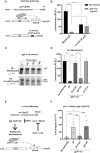microRNA-mediated translation repression through GYF-1 and IFE-4 in C. elegans development
- PMID: 33758928
- PMCID: PMC8136787
- DOI: 10.1093/nar/gkab162
microRNA-mediated translation repression through GYF-1 and IFE-4 in C. elegans development
Abstract
microRNA (miRNA)-mediated gene silencing is enacted through the recruitment of effector proteins that direct translational repression or degradation of mRNA targets, but the relative importance of their activities for animal development remains unknown. Our concerted proteomic surveys identified the uncharacterized GYF-domain encoding protein GYF-1 and its direct interaction with IFE-4, the ortholog of the mammalian translation repressor 4EHP, as key miRNA effector proteins in Caenorhabditis elegans. Recruitment of GYF-1 protein to mRNA reporters in vitro or in vivo leads to potent translation repression without affecting the poly(A) tail or impinging on mRNA stability. Loss of gyf-1 is synthetic lethal with hypomorphic alleles of embryonic miR-35-42 and larval (L4) let-7 miRNAs, which is phenocopied through engineered mutations in gyf-1 that abolish interaction with IFE-4. GYF-1/4EHP function is cascade-specific, as loss of gyf-1 had no noticeable impact on the functions of other miRNAs, including lin-4 and lsy-6. Overall, our findings reveal the first direct effector of miRNA-mediated translational repression in C. elegans and its physiological importance for the function of several, but likely not all miRNAs.
© The Author(s) 2021. Published by Oxford University Press on behalf of Nucleic Acids Research.
Figures





Similar articles
-
Poly(A)-binding proteins are required for microRNA-mediated silencing and to promote target deadenylation in C. elegans.Nucleic Acids Res. 2016 Jul 8;44(12):5924-35. doi: 10.1093/nar/gkw276. Epub 2016 Apr 19. Nucleic Acids Res. 2016. PMID: 27095199 Free PMC article.
-
HRPK-1, a conserved KH-domain protein, modulates microRNA activity during Caenorhabditis elegans development.PLoS Genet. 2019 Oct 4;15(10):e1008067. doi: 10.1371/journal.pgen.1008067. eCollection 2019 Oct. PLoS Genet. 2019. PMID: 31584932 Free PMC article.
-
Systematic identification of C. elegans miRISC proteins, miRNAs, and mRNA targets by their interactions with GW182 proteins AIN-1 and AIN-2.Mol Cell. 2007 Nov 30;28(4):598-613. doi: 10.1016/j.molcel.2007.09.014. Mol Cell. 2007. PMID: 18042455 Free PMC article.
-
Translational control of endogenous microRNA target genes in C. elegans.Prog Mol Subcell Biol. 2010;50:21-40. doi: 10.1007/978-3-642-03103-8_2. Prog Mol Subcell Biol. 2010. PMID: 19841879 Review.
-
Uncovering new functions for microRNAs in Caenorhabditis elegans.Curr Biol. 2011 Sep 13;21(17):R668-71. doi: 10.1016/j.cub.2011.07.027. Curr Biol. 2011. PMID: 21920301 Free PMC article. Review.
Cited by
-
Recent advances in understanding microRNA function and regulation in C. elegans.Semin Cell Dev Biol. 2024 Feb 15;154(Pt A):4-13. doi: 10.1016/j.semcdb.2023.03.011. Epub 2023 Apr 11. Semin Cell Dev Biol. 2024. PMID: 37055330 Free PMC article. Review.
-
MiR-375 mitigates retinal angiogenesis by depressing the JAK2/STAT3 pathway.Aging (Albany NY). 2022 Aug 17;14(16):6594-6604. doi: 10.18632/aging.204232. Epub 2022 Aug 17. Aging (Albany NY). 2022. PMID: 35980290 Free PMC article.
-
A translational regulator MHZ9 modulates ethylene signaling in rice.Nat Commun. 2023 Aug 4;14(1):4674. doi: 10.1038/s41467-023-40429-0. Nat Commun. 2023. PMID: 37542048 Free PMC article.
-
Relationship between miR-338-3p and Clinicopathological Parameters, Prognosis, and STAT3 mRNA Expression in Nasopharyngeal Carcinoma.Evid Based Complement Alternat Med. 2021 Oct 19;2021:2681683. doi: 10.1155/2021/2681683. eCollection 2021. Evid Based Complement Alternat Med. 2021. Retraction in: Evid Based Complement Alternat Med. 2023 Jun 21;2023:9843805. doi: 10.1155/2023/9843805. PMID: 34712340 Free PMC article. Retracted.
-
The SARS-CoV-2 protein NSP2 enhances microRNA-mediated translational repression.J Cell Sci. 2023 Oct 1;136(19):jcs261286. doi: 10.1242/jcs.261286. Epub 2023 Oct 11. J Cell Sci. 2023. PMID: 37732428 Free PMC article.
References
-
- Ameres S.L., Zamore P.D.. Diversifying microRNA sequence and function. Nat. Rev. Mol. Cell Biol. 2013; 14:475. - PubMed
-
- Jonas S., Izaurralde E.. Towards a molecular understanding of microRNA-mediated gene silencing. Nat. Rev. Genet. 2015; 16:421. - PubMed
-
- Iwakawa H.-o., Tomari Y.. The functions of MicroRNAs: mRNA decay and translational repression. Trends Cell Biol. 2015; 25:651–665. - PubMed
Publication types
MeSH terms
Substances
Grants and funding
LinkOut - more resources
Full Text Sources
Other Literature Sources
Molecular Biology Databases

